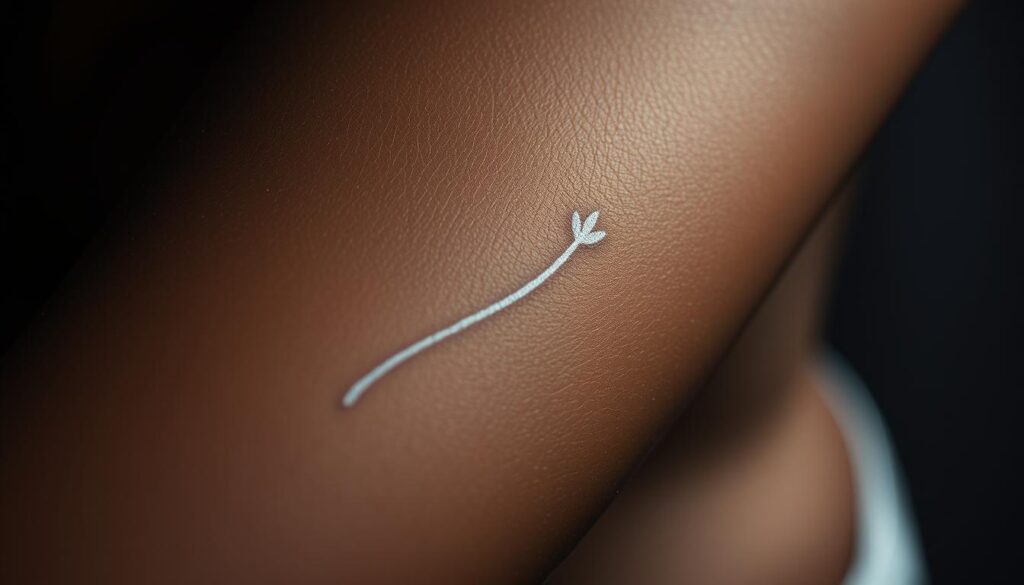
Tattoos have become a popular form of self-expression, with people using ink to tell stories or decorate their bodies. While traditional black tattoos have been around for centuries, white ink tattoos are a modern trend that has caught many people’s attention.
If you have dark skin, you may wonder how well a white tattoo will show up and how long it will last. The unique properties of white ink and its interaction with melanin-rich skin can be quite different from traditional inks.
Understanding these differences is crucial before committing to a design. This guide will explore the essential aspects of getting a white ink tattoo on dark skin.
Key Takeaways
- Understanding how white ink interacts with dark skin
- Factors influencing the final appearance of white ink tattoos
- Challenges and considerations for clients and artists
- Practical advice for finding qualified artists
- Aftercare tips for white ink tattoos on dark skin
Understanding White Ink Tattoos
For those seeking understated body art, white ink tattoos offer a unique solution. These tattoos use white ink, which is much lighter than traditional black ink, giving them a subtle, almost ethereal look.

What Makes White Ink Tattoos Unique
White ink tattoos are characterized by their subtle appearance and unique aesthetic qualities. Unlike conventional tattoos that rely on dark pigments, white ink creates a delicate, sometimes barely-there effect.
The Appeal of White Ink Designs
The appeal of white ink designs lies in their understated elegance and the way they create a raised, textured effect on the skin. Many people are drawn to white tattoos for their discretion, making them popular choices for professional environments.
In summary, white ink tattoos represent a distinctive style in the tattoo world, offering a unique aesthetic that can’t be achieved with darker ink.
White Ink Tattoo on Dark Skin: Reality vs. Expectations
The reality of white ink tattoos on dark skin often surprises clients due to the unique interaction between melanin and white pigment. While the idea of a white ink tattoo might evoke images of stark, bright designs, the actual outcome can be quite different.
Appearance on Darker Skin Tones
On darker skin tones, fresh white ink tattoos typically appear as raised, textured designs with a subtle contrast. The natural skin tone eventually shows over the tattoo, and since white ink is the lightest colored ink, a darker skin tone will begin to show through sooner.

Common Misconceptions
Many people mistakenly believe white ink will appear bright white against dark skin. However, it often creates a subtle, embossed effect where the texture is more noticeable than the color contrast.
The 3D Effect and Raised Appearance
One of the distinctive characteristics of white ink tattoos on dark skin is the pronounced 3D effect. This occurs because white ink contains titanium dioxide, which is denser than other pigments and creates texture as well as color.
| Characteristics | Description |
|---|---|
| Appearance | Raised, textured designs with subtle contrast |
| Misconceptions | Belief that white ink appears bright white on dark skin |
| 3D Effect | Pronounced due to titanium dioxide in white ink |
Challenges and Considerations
While white ink tattoos are gaining popularity, their application on dark skin is not without its challenges. Individuals with darker skin tones need to be aware of the potential issues that may arise when getting a white ink tattoo.
Visibility and Contrast Issues
The primary challenge of white ink tattoos on dark skin is achieving and maintaining visibility. The natural melanin in darker skin tones significantly reduces the contrast between the ink and skin, making the tattoo appear less vibrant or even faded after healing. This reduced contrast can lead to a less defined appearance, which may not be the desired outcome for individuals seeking a bold design.

Healing Process Differences
The healing process for white ink tattoos on dark skin can be more unpredictable. Darker skin may not absorb ink as easily, potentially leading to uneven healing. White ink, in particular, may not settle into the skin as well, resulting in patches where the ink fades or disappears entirely. According to tattoo experts, the healing process can be influenced by various factors, including skin care and aftercare practices (Source).
Longevity Concerns
White ink tattoos tend to fade faster than those made with darker ink, and on dark skin, this fading can be more pronounced. Most white ink tattoos on dark skin will begin showing noticeable fading within 1-3 years, with some designs becoming barely visible after 5 years without touch-ups. Regular maintenance is crucial to maintaining the appearance of these tattoos.
| Consideration | Impact on White Ink Tattoos on Dark Skin |
|---|---|
| Visibility | Reduced contrast due to natural melanin |
| Healing Process | Unpredictable absorption and potential for uneven healing |
| Longevity | Faster fading, potentially requiring regular touch-ups |
It’s essential for individuals with dark skin to consider these challenges and discuss their concerns with a professional tattoo artist before deciding on a white ink tattoo.
Factors Affecting White Ink Tattoo Results
When considering a white ink tattoo on dark skin, several factors come into play that can significantly impact the final result. The appearance and longevity of the tattoo are influenced by a combination of elements, including skin characteristics, tattoo design, and the expertise of the tattoo artist.
Skin Characteristics
The depth and distribution of melanin in the skin play a crucial role in how white ink appears on dark skin. Variations in melanin levels, even among individuals with darker skin tones, can affect the visibility of the tattoo. Additionally, the undertones present in dark skin, whether more red, yellow, or neutral, interact differently with white ink, influencing both the initial appearance and how the tattoo ages.
Tattoo Placement
The location of the tattoo on the body significantly impacts its visibility on dark skin. Areas with naturally thinner skin, such as the inner wrist or chest, tend to show white ink more clearly than thicker-skinned areas. Conversely, locations that experience frequent sun exposure, friction, or have high cell turnover rates, like hands and feet, are challenging for white ink retention.
| Tattoo Placement | Visibility on Dark Skin | Longevity |
|---|---|---|
| Inner Wrist/Chest | High | Moderate |
| Hands/Feet | Low | Low |
| Upper Arm/Back | Moderate | High |
Design Complexity
The complexity of the tattoo design affects its outcome on dark skin. Simple, bold designs with thicker lines tend to remain visible longer than intricate, detailed work with fine lines, which may blur or fade more quickly.
Ink Quality and Technique
The quality of the white ink used and the technique of the tattoo artist are critical factors. High-quality ink containing more titanium dioxide and fewer fillers produces better initial results and longevity. Experienced tattoo artists adjust their techniques for dark skin, using appropriate needle configurations and application pressure to ensure optimal results.

By understanding these factors, individuals with dark skin can make informed decisions when considering a white ink tattoo, ultimately achieving a more satisfactory outcome.
Finding the Right Tattoo Artist

The success of a white ink tattoo on darker skin largely depends on finding an experienced tattoo artist who understands the nuances of working with various skin tones.
Experience with Dark Skin Tones
It’s crucial to find a tattoo artist with specific experience in tattooing dark skin with white ink, as this requires different techniques than tattooing lighter skin tones.
When researching potential artists, look for portfolios that include healed white ink work on clients with skin tones similar to yours.
Portfolio Assessment
A thorough portfolio assessment should include examining the artist’s work at various stages: immediately after tattooing, during the healing process, and months or years after completion.
Consultation and Ink Testing
Professional artists experienced with dark skin will typically recommend an ink test before committing to a full design.
By following these guidelines, you can increase your chances of getting a successful white ink tattoo on dark skin.
The Tattooing Process for Dark Skin
Tattooing on dark skin requires a nuanced approach, particularly when using white ink. The process involves careful preparation, specialized techniques, and a thorough understanding of how white ink interacts with darker skin tones.
Preparation and Precision
The tattooing process begins with thorough preparation. Experienced tattoo artists select appropriate stencil colors, typically blue or purple, as these are more visible on darker skin tones. The artist will also spend extra time on stencil placement to ensure precision, as the subtle nature of white ink means that accurate positioning is crucial.
Technique Adjustments for Dark Skin
When applying white ink to dark skin, tattoo artists must adjust their technique. This includes modifying needle depth, machine speed, and hand pressure to ensure proper ink deposition without causing excessive trauma to the skin. A slower, more methodical approach is often used to prevent overworking the area, which can lead to scarring.
What to Expect During the Session
During the session, clients should expect the process to potentially take longer than a comparable black ink tattoo. The artist will frequently wipe away excess ink and blood to assess the deposition of the white ink, making adjustments as needed. Immediately after application, the tattoo may appear more visible and raised than it will once healed.
| Key Considerations | Description |
|---|---|
| Stencil Color | Blue or purple stencils are used for better visibility on dark skin. |
| Technique Adjustment | Needle depth, machine speed, and hand pressure are adjusted for white ink on dark skin. |
| Session Duration | The process may take longer than a black ink tattoo session. |

Aftercare for White Ink Tattoos on Dark Skin
White ink tattoos on dark skin require special aftercare to promote healing and visibility. Proper care is crucial to maintain the tattoo’s appearance and prevent complications.
Immediate Post-Tattoo Care
Immediately after getting a white ink tattoo, the artist will clean the area and apply a specialized bandage. This bandage should remain in place for 24-48 hours. After removal, gently clean the tattoo with fragrance-free soap and lukewarm water 2-3 times daily.
Long-term Maintenance
Moisturizing is key to preventing excessive scabbing that may pull out the white pigment. Use a fragrance-free moisturizer recommended by your artist. Sun protection is also critical; use a minimum SPF50 sunscreen specifically formulated for tattoos once the tattoo is fully healed.

Signs of Proper Healing vs. Complications
Signs of proper healing include gradual reduction in redness and swelling, and light flaking without thick scabs. Warning signs that require medical attention include excessive redness, unusual warmth, or pus. Proper aftercare ensures your white ink tattoo on dark skin heals correctly and maintains its visibility.
Conclusion: Is a White Ink Tattoo Right for Your Dark Skin?
The decision to get a white ink tattoo on dark skin should be made after careful consideration of several key factors that affect its appearance and longevity. White ink tattoos can offer a unique, subtle aesthetic that is beautiful when approached with realistic expectations. They create a different effect than traditional tattoos, more akin to scarification or embossed art. To ensure the best results, it’s crucial to work with a tattoo artist experienced in white ink on dark skin tones. Consider your lifestyle and the placement of the tattoo carefully, as these factors significantly impact its success. With proper care and maintenance, a white ink tattoo can be a beautiful and distinctive choice for your dark skin.
- Choose a design that complements the unique properties of white ink on dark skin.
- Be prepared for potential touch-ups to maintain visibility.
- Understand that white ink tattoos evolve over time.
By making an informed decision and committing to proper aftercare, you can enjoy a stunning white ink tattoo that remains vibrant for years to come.
